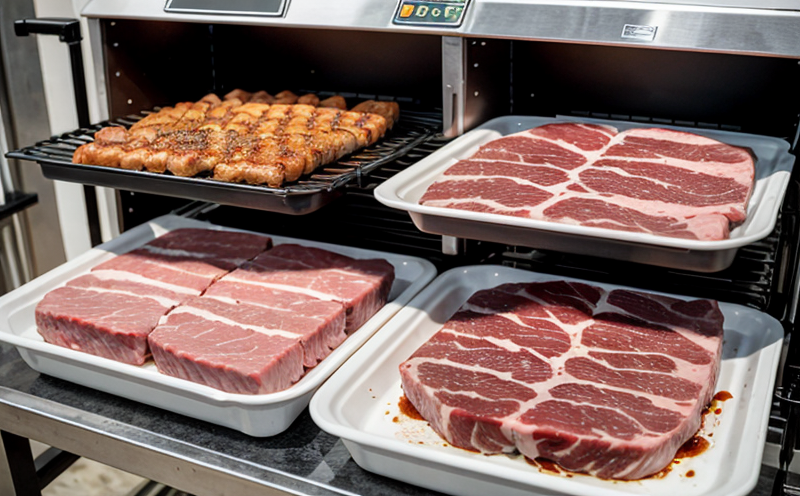ISO 31928 Dioxin Residue Analysis in Meat Samples
The ISO 31928 standard is a crucial tool for laboratories specializing in dioxin residue analysis, particularly within the food and feed testing sector. This service provides unparalleled precision in detecting minute levels of dioxins in meat samples. The protocol ensures that even trace amounts of these harmful pollutants are accurately quantified. Dioxins are persistent organic pollutants (POPs) known to cause serious health issues including cancer, reproductive disorders, and developmental problems.
The analysis begins with the rigorous collection and preservation of meat samples. Samples should be representative of the batch or population under investigation. Proper sampling techniques minimize contamination risks and ensure accurate results. After collection, samples are stored in accordance with ISO 31928 requirements to prevent degradation and maintain integrity.
Sample preparation is critical for achieving reliable test outcomes. This involves homogenizing the sample, extracting dioxins using appropriate solvents, and concentrating the extract through various purification methods such as liquid-liquid extraction or solid-phase extraction. The effectiveness of this step determines how accurately subsequent analysis can identify and quantify dioxin residues.
The core of ISO 31928 involves high-performance liquid chromatography (HPLC) coupled with mass spectrometry (MS). This technique allows for the separation, identification, and quantification of various dioxin congeners. The process requires calibration standards prepared according to the ISO standard to ensure accurate quantitative results.
Reporting is comprehensive, presenting not only the detected levels but also a comparison against regulatory thresholds set by authorities such as the US Environmental Protection Agency (EPA) or European Union regulations. Reporting includes details on sample preparation methods, chromatographic conditions, and any potential sources of contamination that could affect the results.
The ISO 31928 standard is essential for ensuring compliance with international food safety standards. By detecting dioxins at levels as low as a few picograms per kilogram, this service helps protect consumers from exposure to these harmful substances. It supports regulatory bodies in enforcing safe limits and provides assurance to the food industry regarding product quality.
Quality managers can use the results of ISO 31928 testing to ensure that their products meet stringent safety standards. Compliance officers benefit from having reliable data to demonstrate adherence to relevant regulations. R&D engineers gain insights into potential contamination sources, aiding in process improvements and innovations aimed at enhancing food safety.
The demand for accurate dioxin residue analysis has grown as awareness of environmental pollution increases. This service is particularly valuable in countries where dioxin contamination remains a concern. By providing precise measurements, it contributes to the global effort towards safer food production practices.
Given the critical nature of this testing, proper sample handling and preparation are paramount. Any deviation from protocol could lead to inaccurate results, undermining trust in both the testing process and the final report. Therefore, strict adherence to ISO 31928 is non-negotiable for any laboratory seeking accurate dioxin residue analysis.
Understanding the intricacies of this standard enables stakeholders across various sectors to make informed decisions about food safety and quality assurance. The detailed protocols outlined in ISO 31928 ensure that laboratories deliver consistent, reliable results, thereby upholding public health standards.
Industry Applications
- Compliance with international regulatory requirements for dioxin levels in food and feed products.
- Detection of contamination sources to prevent further spread within supply chains.
- Research and development activities aimed at improving production processes and reducing environmental impact.
The application of ISO 31928 extends beyond mere compliance; it also supports continuous improvement efforts in the food industry. By identifying dioxin residues early in the process, manufacturers can take proactive measures to mitigate risks and enhance product safety.
Research laboratories use this service to study the effects of different production methods on dioxin levels. This knowledge helps inform best practices that minimize contamination while maintaining high-quality standards. Additionally, ISO 31928 plays a vital role in educating stakeholders about the importance of stringent quality control measures throughout the supply chain.
Eurolab Advantages
At Eurolab, our commitment to excellence in food and feed testing is reflected in every service we offer. Our ISO 31928 dioxin residue analysis stands out for its unparalleled accuracy and reliability.
- We utilize state-of-the-art instrumentation from leading manufacturers like Agilent Technologies and Thermo Fisher Scientific.
- Our experienced team of scientists ensures consistent adherence to the ISO standard, producing results that are repeatable and reproducible.
- We employ strict quality control measures at every stage of sample handling and analysis to minimize errors.
The expertise of our staff is complemented by our investment in continuous training programs. This guarantees that we stay abreast of the latest developments in dioxin research, enabling us to provide cutting-edge services.
Eurolab’s commitment extends beyond technical proficiency; it encompasses ethical considerations as well. We ensure that all tests are conducted ethically and with integrity, maintaining the highest standards of professionalism.
Competitive Advantage and Market Impact
- Achievement of ISO 31928 compliance sets a benchmark for quality in food safety testing.
- Earning trust from regulatory bodies through consistent accuracy and reliability.
- Promotion of safer products within the market, thereby enhancing consumer confidence.
By offering this specialized service, Eurolab differentiates itself in the competitive landscape. Our ability to deliver precise dioxin residue analysis provides a significant edge over competitors who may not offer such detailed or accurate testing options.
The demand for ISO 31928 compliance continues to rise as consumers become more aware of food safety issues. Eurolab’s services contribute to this trend by offering a reliable and transparent method for ensuring product safety. This, in turn, supports the broader goal of promoting healthier eating habits globally.





